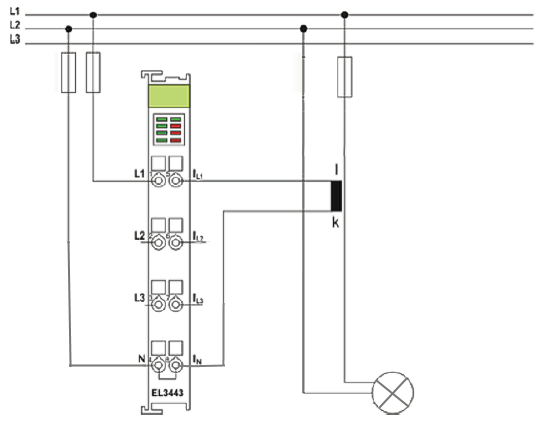Power measurement on loads with phase-to-phase voltages
In some cases it may be useful, for the purpose of increasing the power, to operate some consumers in a three-phase network with the phase-to-phase voltage. As this is larger than the phase voltages by a factor of √3, the power also increases by a factor of √3 with the same current or, as the case may be, the same power can be achieved with a lower current.
When using the EL3443 and EL3453, the limitation of the maximum measuring voltage between ULx and N has been taken into account. The technical measuring range of the EL3453 is approx. 130 % larger than the nominal measuring range. Therefore, phase-to-phase voltages of up to 277 V can be measured with the EL3443, and nominally up to 400 V and technically up to 520 V with the EL3453. In the case of the EL3453, the maximum time for voltages above 500 V must be taken into account if the nominal measuring range is exceeded (see EL3453-0x00)
As standard, the EL3443 and EL3453 measure the phase voltages and currents. If wired correctly, however, the phase-to-phase voltages and the currents through the connected consumers can also be measured and the associated power values calculated. In order to measure the voltage and current correctly and thus to determine the correct power values, the EL3443 or EL3453 respectively must be wired as follows:
EL3443
 Fig.179: EL3443 – wiring for measurement of the phase-to-phase voltage
Fig.179: EL3443 – wiring for measurement of the phase-to-phase voltageThe phase-to-phase voltage between L1 and L2 is measured on the terminal between L1 and N. The voltage of phase L2 is thus the reference potential for phase L1 in order to be able to measure the voltage between the phases.
The current is measured between the current measuring channel for the first phase and the current measuring channel for N or the reference point respectively. When the current between L1 and L2 is measured, the terminal expects the current of phase L1. In a setup with only one consumer, this corresponds to the current that flows through the consumer. If there are several consumers, however, the current is divided at each node accordingly.
EL3453
 Fig.180: EL3453 – wiring for measurement of the phase-to-phase voltage
Fig.180: EL3453 – wiring for measurement of the phase-to-phase voltageThe phase-to-phase voltage between L1 and L2 is measured on the terminal between L1 and N. The voltage of phase L2 is thus the reference potential for phase L1 in order to be able to measure the voltage between the phases.
The current to be measured is the current through the consumer. This is the current that flows from phase 1 through the consumer to phase 2. Using a current transformer, this current can be measured differentially with the EL3453 on the current measuring channel IL1, so that the associated power and energy values can be calculated.